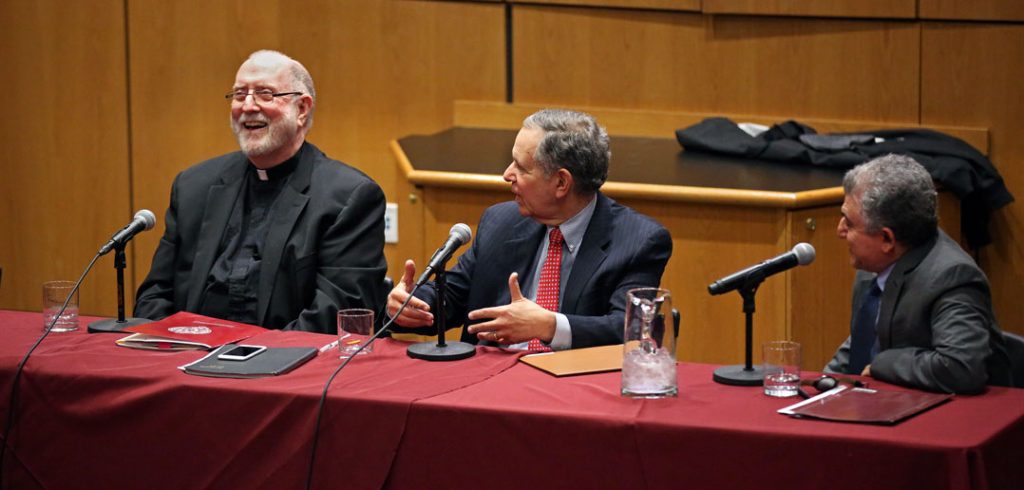Imitation can take on many forms—behavior, manner of prayer, and even dress, said Father Ryan, the Laurence J. McGinley Professor of Religion and Society at Fordham. He cited several traditional and conservative aspects of imitation that eschew modernity.
‘A Clear Path of God’s Command’
He noted that the dress and appearance of Hasidic Jews mirrors that of past rabbis, “mystical masters” known as zaddikim. And while their dress may look different from modern street clothes to an outsider, he said, it is through “their very difference that they demonstrate their imitation of past rabbis and their fidelity to God.”
“To imitate one’s zaddik, to walk in the paths of ancestors in the faith, lies close to the heart of what the faith of Israel has meant for nearly four millennia,” he said.
Likewise, in Islam, accounts of what Muhammad said and did were written down to guide “requirements of ritual purity” that validate worship and all other aspects of life.
“We have put you on a clear path of God’s command. Follow it and do not follow the vagaries of those who know nothing,” Father Ryan said, quoting the Qur’an (45:18).
“Muslims have taken [this]divinely guided way of proceeding in every aspect of life more seriously and more literally than have Christians; in this they more closely resemble Orthodox Jews,” he said.
Each religion varies on the degree to which the followers adhere to such imitations, he said. In the case of Christianity, he cited St. Paul: “Be imitators of me as I am of Christ” (1 Cor 11:1).
He noted that the monastic movements in first-millennium Christianity withdrew from the “corrupting secular world” while “Carmelites Franciscans, Dominicans and Augustinians, most prominently, sometimes engaged with the secular world but also withdrew from it into their convents from time to time.” In the late 14th century, however, starting in the eastern Netherlands, the Devotio Moderna movement appealed to laity and the lower ranks of the clergy, urging them to engage with the world but to eschew its corrupting standards, imitating the poverty and simplicity of Christ. The movement began with popular Catholic preacher Geert Grote, who died in 1384, but was most famously memorialized by Thomas à Kempis and his devotional book Imitation of Christ.
Father Ryan noted that in the Spiritual Exercises of St. Ignatius, the one making the exercise asks to “to imitate [Jesus] in enduring every outrage and all contempt, and utter poverty, both actual and spiritual.”
Imitation in the Age of Smartphones
Following the lecture, the conversation took a contemporary turn when the evening’s moderator, William F. Kuntz Jr., a judge of the Second Federal Court in the Eastern District Court of New York, reflected on whether it was possible—in this age of smartphones—to turn away from modernity and imitate God and the prophets in a traditional manner.
“What would each of the faith traditions say about the innovations of Facebook and the internet?” he asked.
“There’s a strand with every religion that has a problem with any innovation,” said Rabbi Daniel Polish, Ph.D., of Congregation Shir Chadash in Poughkeepsie, one of the lecture’s respondents. “There’s a tension between those that refuse to adapt and early adapters.”
Father Ryan agreed. “There were condemnations of the railroad in the 19th century by the papacy,” he said.
Yet times change and technology moves forward. So how is one to adapt to modern times and yet remain faithful?
Zaki Saritoprak, who holds the Nursi Chair in Islamic Studies of John Carroll University and was also a respondent, said that like any technology, its value depends on how it’s used.
“You have a car; you can drive to a good place or bad place,” he said. “If [technology]prevents you from your major duties, like your responsibility to pray, then it becomes problematic.”
And yet, the same innovations can help with prayer, said Rabbi Polish, noting how many religious texts are now available online.
“The extreme Orthodox have made use of cell phones to access vast storehouses of information,” he said.
He recalled a recent service within the Hasidic community. “When it comes time to pray, they all pull out the cell phone and open to the appropriate app,” he said. “We were praying literally off our phones.”
Related Coverage: Anthropologist Researches Internet Use in Ultra-Orthodox Communities


